Hydroponics Company Limited: Governance in a Globalizing World
VerifiedAdded on 2021/04/21
|13
|2645
|74
Report
AI Summary
This report provides a comprehensive analysis of corporate governance in a globalizing world, using the case of Hydroponics Company Limited as a central example. The report begins with a summary of the allegations against Hydroponics, focusing on failures in disclosure obligations and the subsequent board replacement. It then explores key corporate governance principles, including agency, stewardship, resource-dependence, and stakeholder theories, highlighting the issues associated with each. The analysis connects these theories to the Hydroponics case, emphasizing the importance of transparency and shareholder activism. The report further discusses the significance of corporate transparency for both businesses and the public, citing the ASX Corporate Governance Principles and Recommendations. The report concludes with a self-perspective on the governance issues discussed, offering insights on the implications of shareholder activism and the importance of ethical practices. The report underscores the need for transparent and accountable corporate governance structures to maintain stakeholder trust and ensure sustainable business operations.
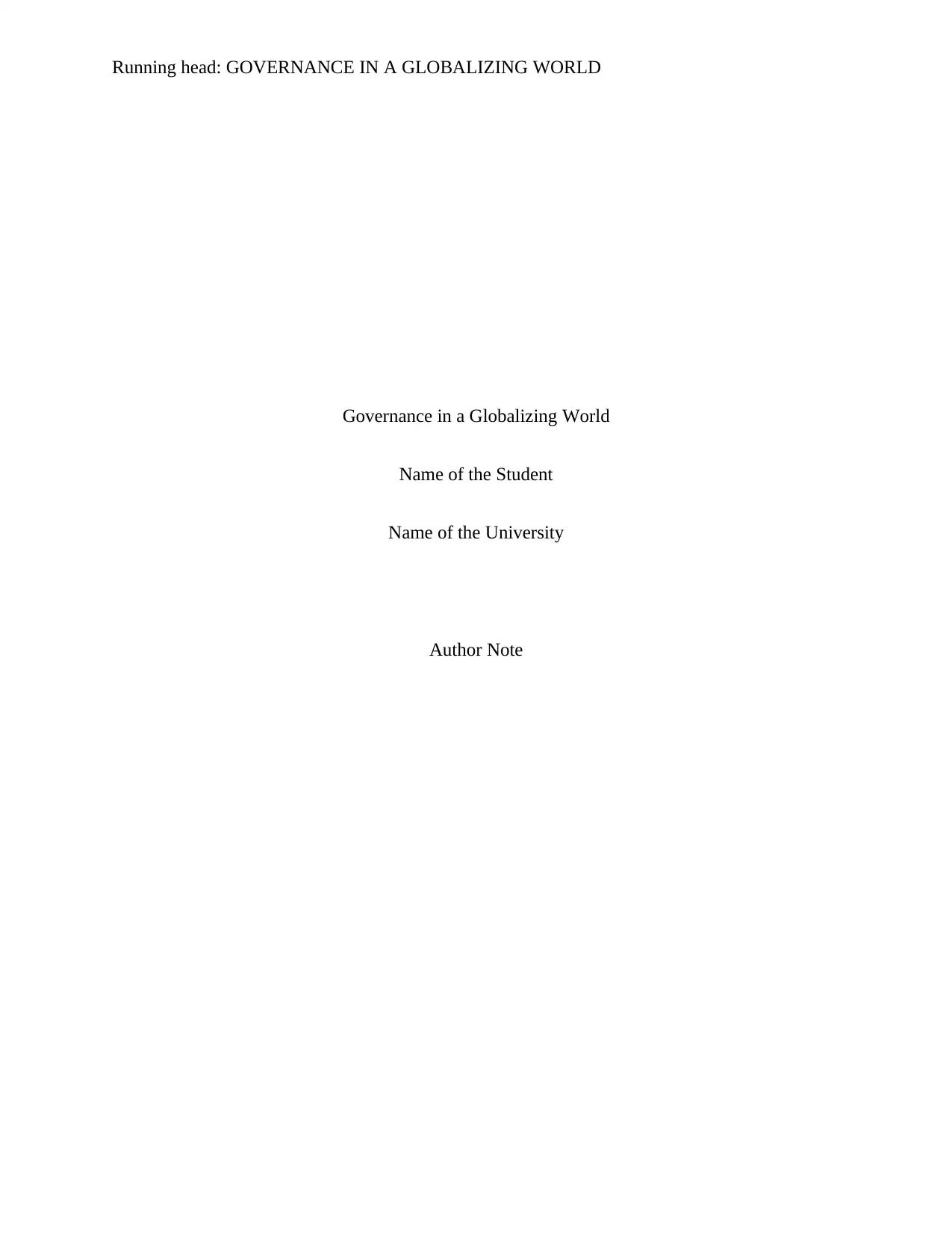
Running head: GOVERNANCE IN A GLOBALIZING WORLD
Governance in a Globalizing World
Name of the Student
Name of the University
Author Note
Governance in a Globalizing World
Name of the Student
Name of the University
Author Note
Paraphrase This Document
Need a fresh take? Get an instant paraphrase of this document with our AI Paraphraser
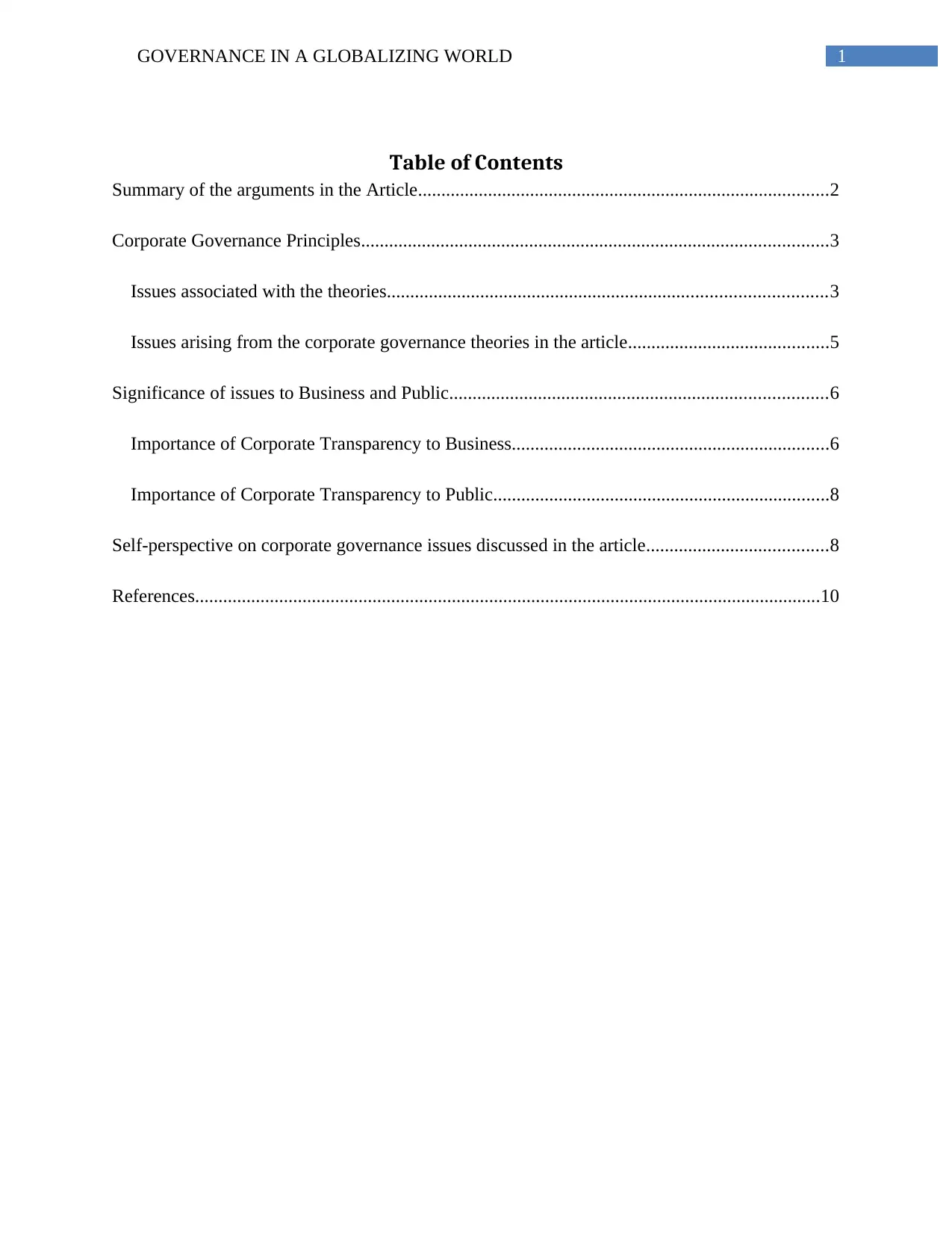
1GOVERNANCE IN A GLOBALIZING WORLD
Table of Contents
Summary of the arguments in the Article........................................................................................2
Corporate Governance Principles....................................................................................................3
Issues associated with the theories..............................................................................................3
Issues arising from the corporate governance theories in the article...........................................5
Significance of issues to Business and Public.................................................................................6
Importance of Corporate Transparency to Business....................................................................6
Importance of Corporate Transparency to Public........................................................................8
Self-perspective on corporate governance issues discussed in the article.......................................8
References......................................................................................................................................10
Table of Contents
Summary of the arguments in the Article........................................................................................2
Corporate Governance Principles....................................................................................................3
Issues associated with the theories..............................................................................................3
Issues arising from the corporate governance theories in the article...........................................5
Significance of issues to Business and Public.................................................................................6
Importance of Corporate Transparency to Business....................................................................6
Importance of Corporate Transparency to Public........................................................................8
Self-perspective on corporate governance issues discussed in the article.......................................8
References......................................................................................................................................10
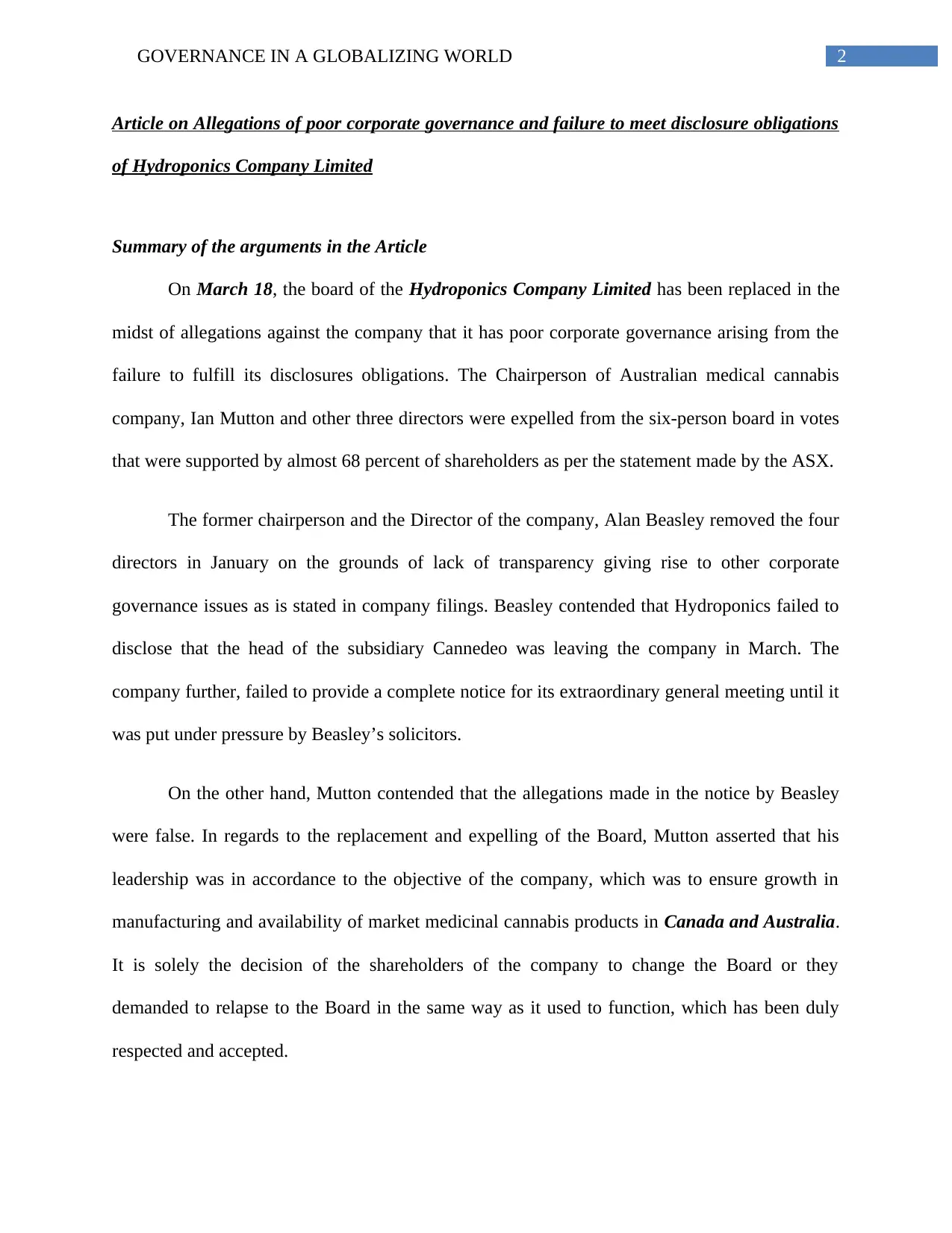
2GOVERNANCE IN A GLOBALIZING WORLD
Article on Allegations of poor corporate governance and failure to meet disclosure obligations
of Hydroponics Company Limited
Summary of the arguments in the Article
On March 18, the board of the Hydroponics Company Limited has been replaced in the
midst of allegations against the company that it has poor corporate governance arising from the
failure to fulfill its disclosures obligations. The Chairperson of Australian medical cannabis
company, Ian Mutton and other three directors were expelled from the six-person board in votes
that were supported by almost 68 percent of shareholders as per the statement made by the ASX.
The former chairperson and the Director of the company, Alan Beasley removed the four
directors in January on the grounds of lack of transparency giving rise to other corporate
governance issues as is stated in company filings. Beasley contended that Hydroponics failed to
disclose that the head of the subsidiary Cannedeo was leaving the company in March. The
company further, failed to provide a complete notice for its extraordinary general meeting until it
was put under pressure by Beasley’s solicitors.
On the other hand, Mutton contended that the allegations made in the notice by Beasley
were false. In regards to the replacement and expelling of the Board, Mutton asserted that his
leadership was in accordance to the objective of the company, which was to ensure growth in
manufacturing and availability of market medicinal cannabis products in Canada and Australia.
It is solely the decision of the shareholders of the company to change the Board or they
demanded to relapse to the Board in the same way as it used to function, which has been duly
respected and accepted.
Article on Allegations of poor corporate governance and failure to meet disclosure obligations
of Hydroponics Company Limited
Summary of the arguments in the Article
On March 18, the board of the Hydroponics Company Limited has been replaced in the
midst of allegations against the company that it has poor corporate governance arising from the
failure to fulfill its disclosures obligations. The Chairperson of Australian medical cannabis
company, Ian Mutton and other three directors were expelled from the six-person board in votes
that were supported by almost 68 percent of shareholders as per the statement made by the ASX.
The former chairperson and the Director of the company, Alan Beasley removed the four
directors in January on the grounds of lack of transparency giving rise to other corporate
governance issues as is stated in company filings. Beasley contended that Hydroponics failed to
disclose that the head of the subsidiary Cannedeo was leaving the company in March. The
company further, failed to provide a complete notice for its extraordinary general meeting until it
was put under pressure by Beasley’s solicitors.
On the other hand, Mutton contended that the allegations made in the notice by Beasley
were false. In regards to the replacement and expelling of the Board, Mutton asserted that his
leadership was in accordance to the objective of the company, which was to ensure growth in
manufacturing and availability of market medicinal cannabis products in Canada and Australia.
It is solely the decision of the shareholders of the company to change the Board or they
demanded to relapse to the Board in the same way as it used to function, which has been duly
respected and accepted.
⊘ This is a preview!⊘
Do you want full access?
Subscribe today to unlock all pages.

Trusted by 1+ million students worldwide
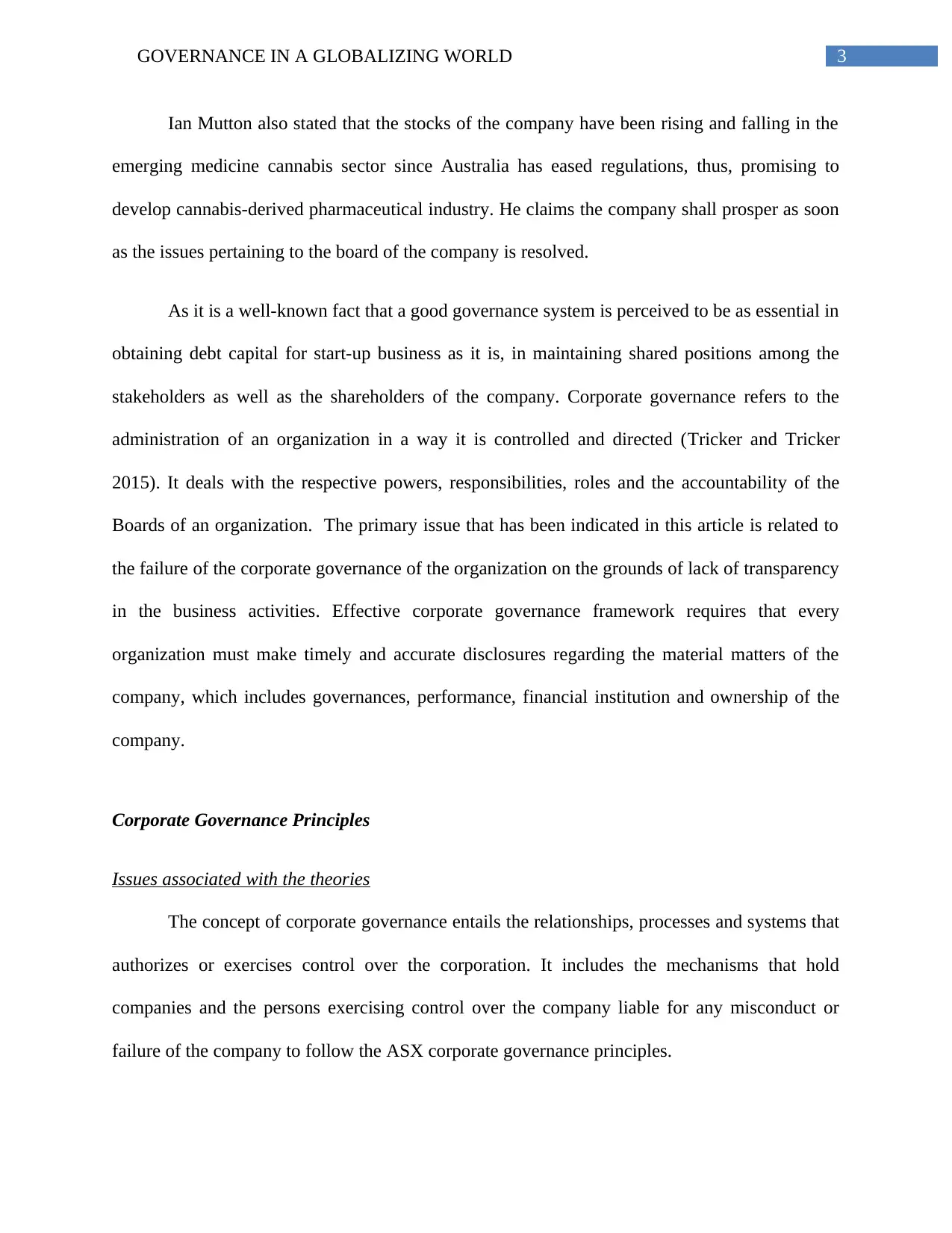
3GOVERNANCE IN A GLOBALIZING WORLD
Ian Mutton also stated that the stocks of the company have been rising and falling in the
emerging medicine cannabis sector since Australia has eased regulations, thus, promising to
develop cannabis-derived pharmaceutical industry. He claims the company shall prosper as soon
as the issues pertaining to the board of the company is resolved.
As it is a well-known fact that a good governance system is perceived to be as essential in
obtaining debt capital for start-up business as it is, in maintaining shared positions among the
stakeholders as well as the shareholders of the company. Corporate governance refers to the
administration of an organization in a way it is controlled and directed (Tricker and Tricker
2015). It deals with the respective powers, responsibilities, roles and the accountability of the
Boards of an organization. The primary issue that has been indicated in this article is related to
the failure of the corporate governance of the organization on the grounds of lack of transparency
in the business activities. Effective corporate governance framework requires that every
organization must make timely and accurate disclosures regarding the material matters of the
company, which includes governances, performance, financial institution and ownership of the
company.
Corporate Governance Principles
Issues associated with the theories
The concept of corporate governance entails the relationships, processes and systems that
authorizes or exercises control over the corporation. It includes the mechanisms that hold
companies and the persons exercising control over the company liable for any misconduct or
failure of the company to follow the ASX corporate governance principles.
Ian Mutton also stated that the stocks of the company have been rising and falling in the
emerging medicine cannabis sector since Australia has eased regulations, thus, promising to
develop cannabis-derived pharmaceutical industry. He claims the company shall prosper as soon
as the issues pertaining to the board of the company is resolved.
As it is a well-known fact that a good governance system is perceived to be as essential in
obtaining debt capital for start-up business as it is, in maintaining shared positions among the
stakeholders as well as the shareholders of the company. Corporate governance refers to the
administration of an organization in a way it is controlled and directed (Tricker and Tricker
2015). It deals with the respective powers, responsibilities, roles and the accountability of the
Boards of an organization. The primary issue that has been indicated in this article is related to
the failure of the corporate governance of the organization on the grounds of lack of transparency
in the business activities. Effective corporate governance framework requires that every
organization must make timely and accurate disclosures regarding the material matters of the
company, which includes governances, performance, financial institution and ownership of the
company.
Corporate Governance Principles
Issues associated with the theories
The concept of corporate governance entails the relationships, processes and systems that
authorizes or exercises control over the corporation. It includes the mechanisms that hold
companies and the persons exercising control over the company liable for any misconduct or
failure of the company to follow the ASX corporate governance principles.
Paraphrase This Document
Need a fresh take? Get an instant paraphrase of this document with our AI Paraphraser
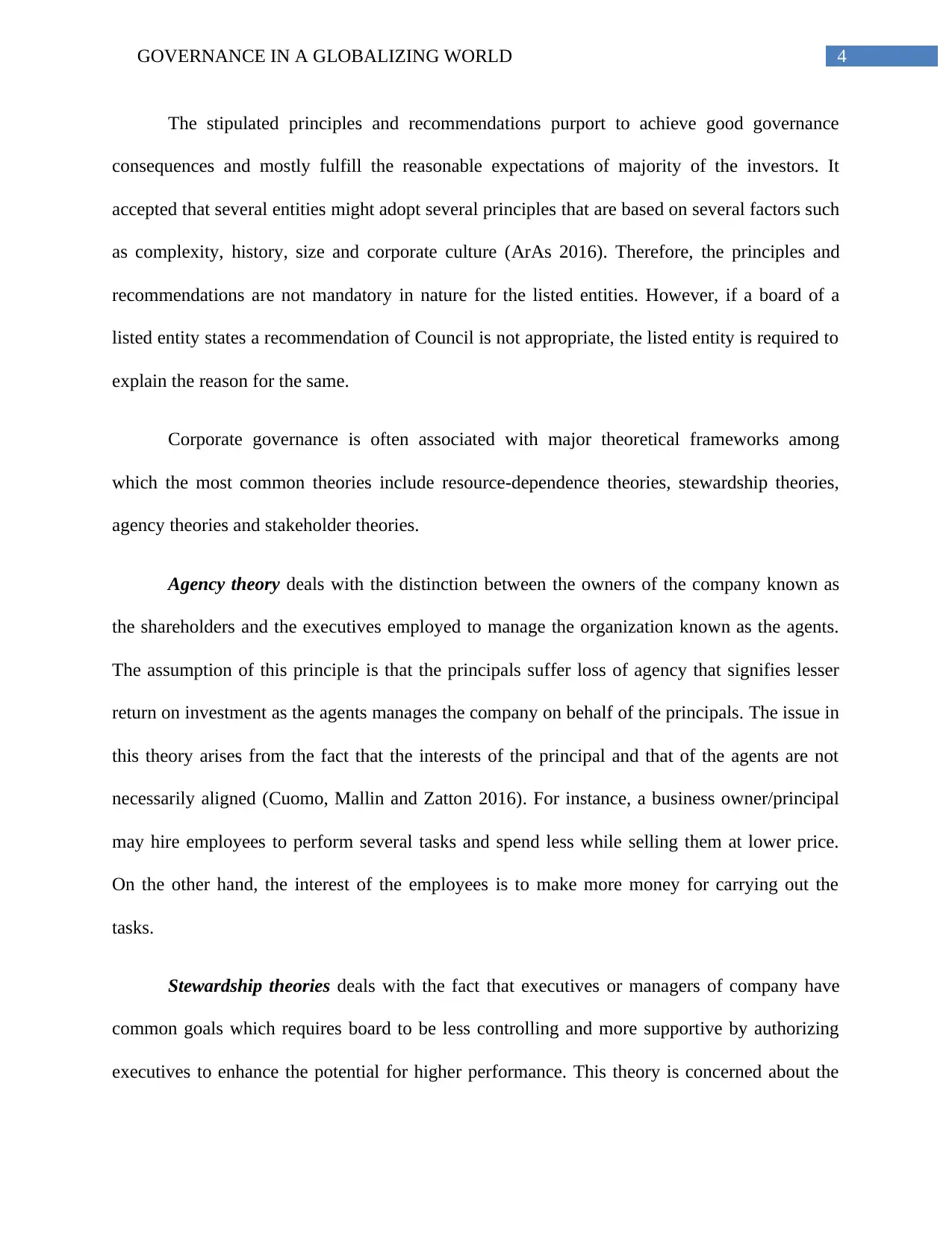
4GOVERNANCE IN A GLOBALIZING WORLD
The stipulated principles and recommendations purport to achieve good governance
consequences and mostly fulfill the reasonable expectations of majority of the investors. It
accepted that several entities might adopt several principles that are based on several factors such
as complexity, history, size and corporate culture (ArAs 2016). Therefore, the principles and
recommendations are not mandatory in nature for the listed entities. However, if a board of a
listed entity states a recommendation of Council is not appropriate, the listed entity is required to
explain the reason for the same.
Corporate governance is often associated with major theoretical frameworks among
which the most common theories include resource-dependence theories, stewardship theories,
agency theories and stakeholder theories.
Agency theory deals with the distinction between the owners of the company known as
the shareholders and the executives employed to manage the organization known as the agents.
The assumption of this principle is that the principals suffer loss of agency that signifies lesser
return on investment as the agents manages the company on behalf of the principals. The issue in
this theory arises from the fact that the interests of the principal and that of the agents are not
necessarily aligned (Cuomo, Mallin and Zatton 2016). For instance, a business owner/principal
may hire employees to perform several tasks and spend less while selling them at lower price.
On the other hand, the interest of the employees is to make more money for carrying out the
tasks.
Stewardship theories deals with the fact that executives or managers of company have
common goals which requires board to be less controlling and more supportive by authorizing
executives to enhance the potential for higher performance. This theory is concerned about the
The stipulated principles and recommendations purport to achieve good governance
consequences and mostly fulfill the reasonable expectations of majority of the investors. It
accepted that several entities might adopt several principles that are based on several factors such
as complexity, history, size and corporate culture (ArAs 2016). Therefore, the principles and
recommendations are not mandatory in nature for the listed entities. However, if a board of a
listed entity states a recommendation of Council is not appropriate, the listed entity is required to
explain the reason for the same.
Corporate governance is often associated with major theoretical frameworks among
which the most common theories include resource-dependence theories, stewardship theories,
agency theories and stakeholder theories.
Agency theory deals with the distinction between the owners of the company known as
the shareholders and the executives employed to manage the organization known as the agents.
The assumption of this principle is that the principals suffer loss of agency that signifies lesser
return on investment as the agents manages the company on behalf of the principals. The issue in
this theory arises from the fact that the interests of the principal and that of the agents are not
necessarily aligned (Cuomo, Mallin and Zatton 2016). For instance, a business owner/principal
may hire employees to perform several tasks and spend less while selling them at lower price.
On the other hand, the interest of the employees is to make more money for carrying out the
tasks.
Stewardship theories deals with the fact that executives or managers of company have
common goals which requires board to be less controlling and more supportive by authorizing
executives to enhance the potential for higher performance. This theory is concerned about the
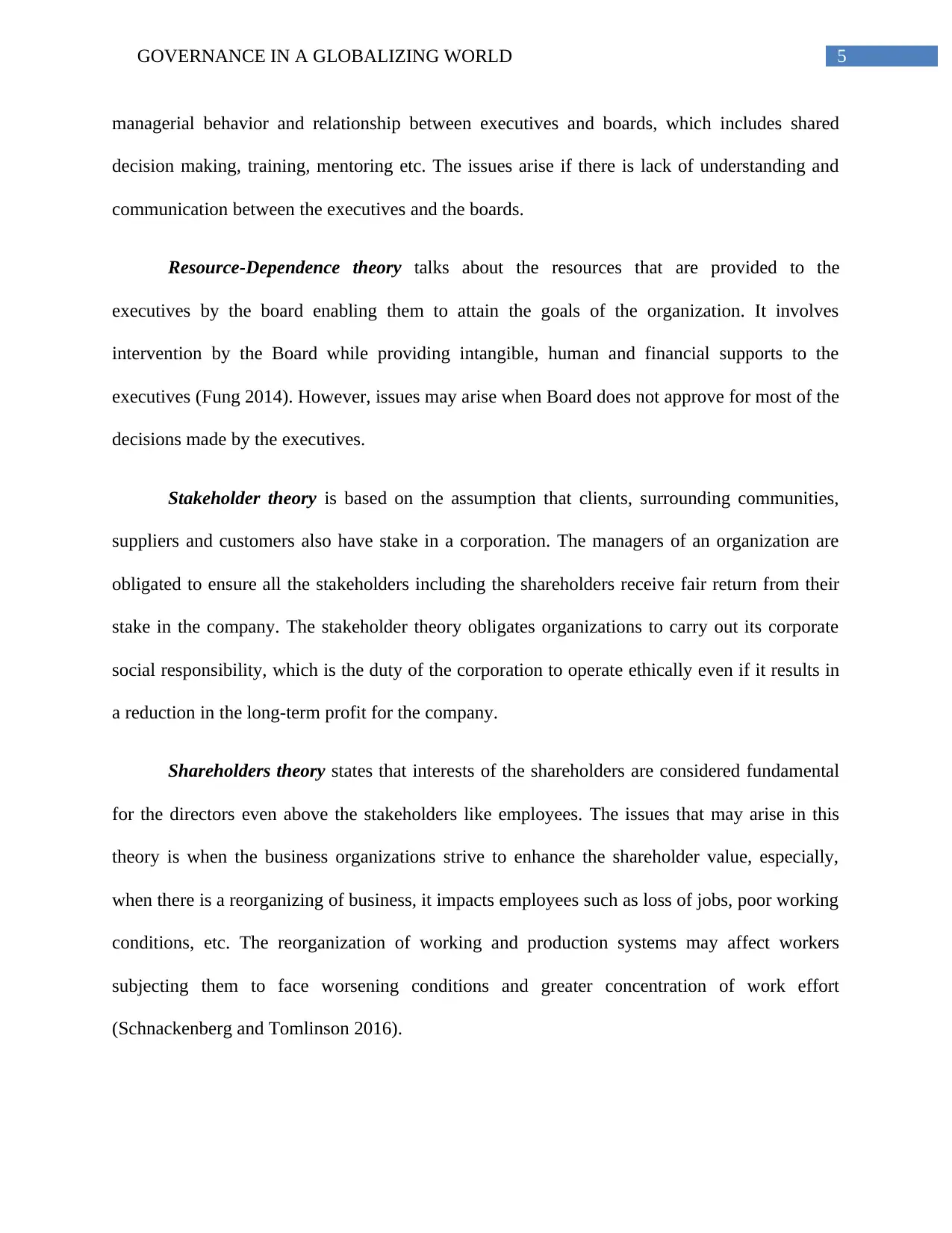
5GOVERNANCE IN A GLOBALIZING WORLD
managerial behavior and relationship between executives and boards, which includes shared
decision making, training, mentoring etc. The issues arise if there is lack of understanding and
communication between the executives and the boards.
Resource-Dependence theory talks about the resources that are provided to the
executives by the board enabling them to attain the goals of the organization. It involves
intervention by the Board while providing intangible, human and financial supports to the
executives (Fung 2014). However, issues may arise when Board does not approve for most of the
decisions made by the executives.
Stakeholder theory is based on the assumption that clients, surrounding communities,
suppliers and customers also have stake in a corporation. The managers of an organization are
obligated to ensure all the stakeholders including the shareholders receive fair return from their
stake in the company. The stakeholder theory obligates organizations to carry out its corporate
social responsibility, which is the duty of the corporation to operate ethically even if it results in
a reduction in the long-term profit for the company.
Shareholders theory states that interests of the shareholders are considered fundamental
for the directors even above the stakeholders like employees. The issues that may arise in this
theory is when the business organizations strive to enhance the shareholder value, especially,
when there is a reorganizing of business, it impacts employees such as loss of jobs, poor working
conditions, etc. The reorganization of working and production systems may affect workers
subjecting them to face worsening conditions and greater concentration of work effort
(Schnackenberg and Tomlinson 2016).
managerial behavior and relationship between executives and boards, which includes shared
decision making, training, mentoring etc. The issues arise if there is lack of understanding and
communication between the executives and the boards.
Resource-Dependence theory talks about the resources that are provided to the
executives by the board enabling them to attain the goals of the organization. It involves
intervention by the Board while providing intangible, human and financial supports to the
executives (Fung 2014). However, issues may arise when Board does not approve for most of the
decisions made by the executives.
Stakeholder theory is based on the assumption that clients, surrounding communities,
suppliers and customers also have stake in a corporation. The managers of an organization are
obligated to ensure all the stakeholders including the shareholders receive fair return from their
stake in the company. The stakeholder theory obligates organizations to carry out its corporate
social responsibility, which is the duty of the corporation to operate ethically even if it results in
a reduction in the long-term profit for the company.
Shareholders theory states that interests of the shareholders are considered fundamental
for the directors even above the stakeholders like employees. The issues that may arise in this
theory is when the business organizations strive to enhance the shareholder value, especially,
when there is a reorganizing of business, it impacts employees such as loss of jobs, poor working
conditions, etc. The reorganization of working and production systems may affect workers
subjecting them to face worsening conditions and greater concentration of work effort
(Schnackenberg and Tomlinson 2016).
⊘ This is a preview!⊘
Do you want full access?
Subscribe today to unlock all pages.

Trusted by 1+ million students worldwide
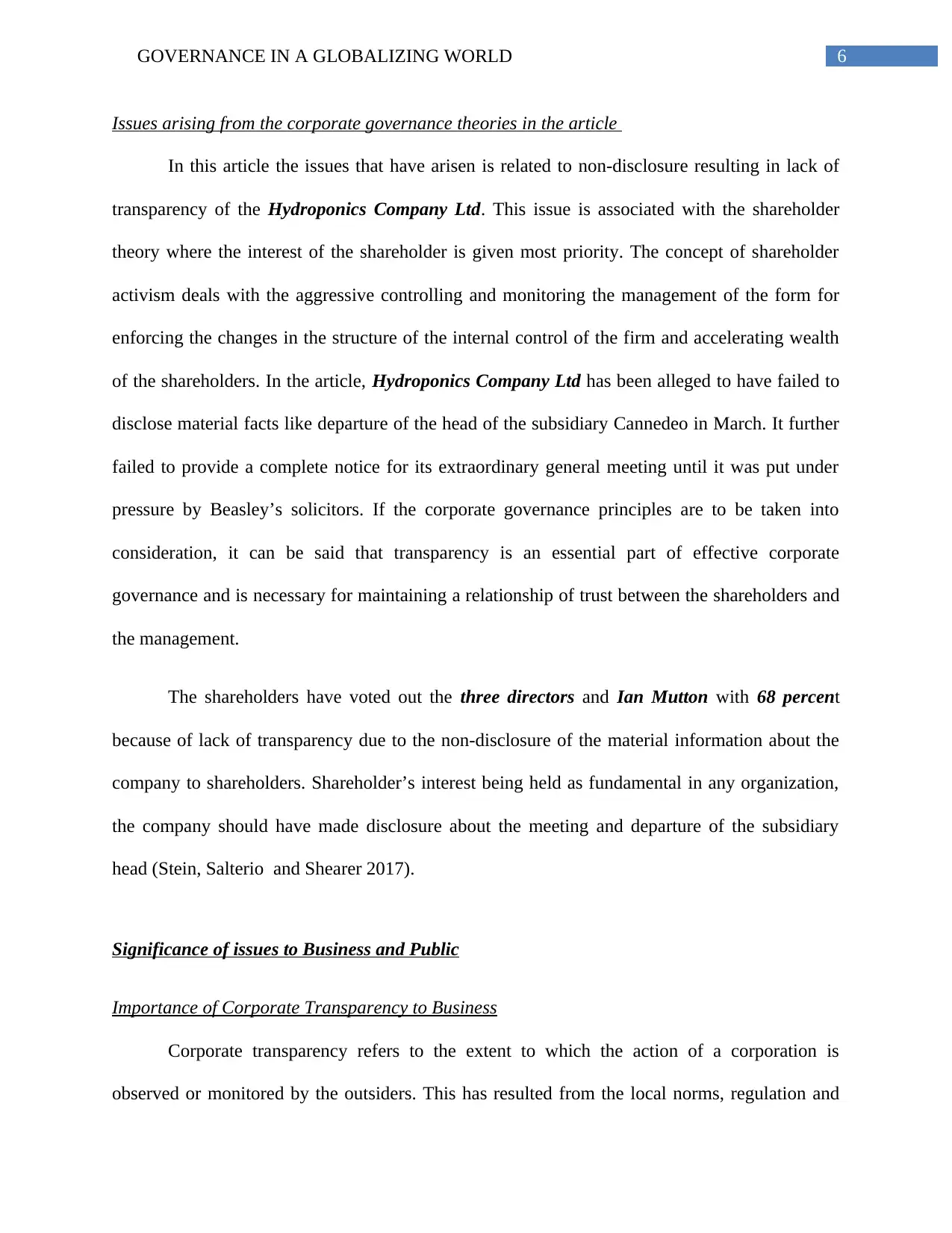
6GOVERNANCE IN A GLOBALIZING WORLD
Issues arising from the corporate governance theories in the article
In this article the issues that have arisen is related to non-disclosure resulting in lack of
transparency of the Hydroponics Company Ltd. This issue is associated with the shareholder
theory where the interest of the shareholder is given most priority. The concept of shareholder
activism deals with the aggressive controlling and monitoring the management of the form for
enforcing the changes in the structure of the internal control of the firm and accelerating wealth
of the shareholders. In the article, Hydroponics Company Ltd has been alleged to have failed to
disclose material facts like departure of the head of the subsidiary Cannedeo in March. It further
failed to provide a complete notice for its extraordinary general meeting until it was put under
pressure by Beasley’s solicitors. If the corporate governance principles are to be taken into
consideration, it can be said that transparency is an essential part of effective corporate
governance and is necessary for maintaining a relationship of trust between the shareholders and
the management.
The shareholders have voted out the three directors and Ian Mutton with 68 percent
because of lack of transparency due to the non-disclosure of the material information about the
company to shareholders. Shareholder’s interest being held as fundamental in any organization,
the company should have made disclosure about the meeting and departure of the subsidiary
head (Stein, Salterio and Shearer 2017).
Significance of issues to Business and Public
Importance of Corporate Transparency to Business
Corporate transparency refers to the extent to which the action of a corporation is
observed or monitored by the outsiders. This has resulted from the local norms, regulation and
Issues arising from the corporate governance theories in the article
In this article the issues that have arisen is related to non-disclosure resulting in lack of
transparency of the Hydroponics Company Ltd. This issue is associated with the shareholder
theory where the interest of the shareholder is given most priority. The concept of shareholder
activism deals with the aggressive controlling and monitoring the management of the form for
enforcing the changes in the structure of the internal control of the firm and accelerating wealth
of the shareholders. In the article, Hydroponics Company Ltd has been alleged to have failed to
disclose material facts like departure of the head of the subsidiary Cannedeo in March. It further
failed to provide a complete notice for its extraordinary general meeting until it was put under
pressure by Beasley’s solicitors. If the corporate governance principles are to be taken into
consideration, it can be said that transparency is an essential part of effective corporate
governance and is necessary for maintaining a relationship of trust between the shareholders and
the management.
The shareholders have voted out the three directors and Ian Mutton with 68 percent
because of lack of transparency due to the non-disclosure of the material information about the
company to shareholders. Shareholder’s interest being held as fundamental in any organization,
the company should have made disclosure about the meeting and departure of the subsidiary
head (Stein, Salterio and Shearer 2017).
Significance of issues to Business and Public
Importance of Corporate Transparency to Business
Corporate transparency refers to the extent to which the action of a corporation is
observed or monitored by the outsiders. This has resulted from the local norms, regulation and
Paraphrase This Document
Need a fresh take? Get an instant paraphrase of this document with our AI Paraphraser
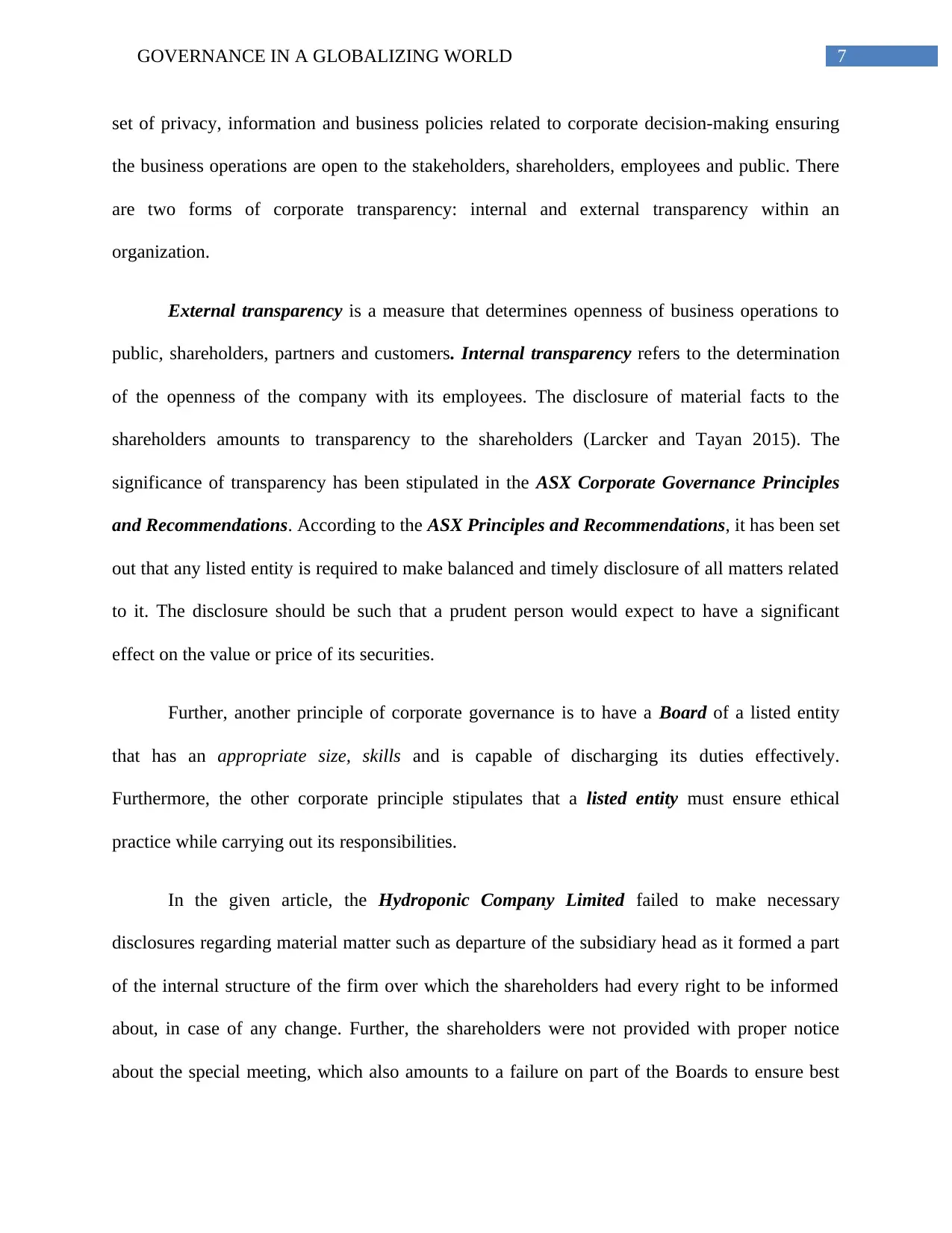
7GOVERNANCE IN A GLOBALIZING WORLD
set of privacy, information and business policies related to corporate decision-making ensuring
the business operations are open to the stakeholders, shareholders, employees and public. There
are two forms of corporate transparency: internal and external transparency within an
organization.
External transparency is a measure that determines openness of business operations to
public, shareholders, partners and customers. Internal transparency refers to the determination
of the openness of the company with its employees. The disclosure of material facts to the
shareholders amounts to transparency to the shareholders (Larcker and Tayan 2015). The
significance of transparency has been stipulated in the ASX Corporate Governance Principles
and Recommendations. According to the ASX Principles and Recommendations, it has been set
out that any listed entity is required to make balanced and timely disclosure of all matters related
to it. The disclosure should be such that a prudent person would expect to have a significant
effect on the value or price of its securities.
Further, another principle of corporate governance is to have a Board of a listed entity
that has an appropriate size, skills and is capable of discharging its duties effectively.
Furthermore, the other corporate principle stipulates that a listed entity must ensure ethical
practice while carrying out its responsibilities.
In the given article, the Hydroponic Company Limited failed to make necessary
disclosures regarding material matter such as departure of the subsidiary head as it formed a part
of the internal structure of the firm over which the shareholders had every right to be informed
about, in case of any change. Further, the shareholders were not provided with proper notice
about the special meeting, which also amounts to a failure on part of the Boards to ensure best
set of privacy, information and business policies related to corporate decision-making ensuring
the business operations are open to the stakeholders, shareholders, employees and public. There
are two forms of corporate transparency: internal and external transparency within an
organization.
External transparency is a measure that determines openness of business operations to
public, shareholders, partners and customers. Internal transparency refers to the determination
of the openness of the company with its employees. The disclosure of material facts to the
shareholders amounts to transparency to the shareholders (Larcker and Tayan 2015). The
significance of transparency has been stipulated in the ASX Corporate Governance Principles
and Recommendations. According to the ASX Principles and Recommendations, it has been set
out that any listed entity is required to make balanced and timely disclosure of all matters related
to it. The disclosure should be such that a prudent person would expect to have a significant
effect on the value or price of its securities.
Further, another principle of corporate governance is to have a Board of a listed entity
that has an appropriate size, skills and is capable of discharging its duties effectively.
Furthermore, the other corporate principle stipulates that a listed entity must ensure ethical
practice while carrying out its responsibilities.
In the given article, the Hydroponic Company Limited failed to make necessary
disclosures regarding material matter such as departure of the subsidiary head as it formed a part
of the internal structure of the firm over which the shareholders had every right to be informed
about, in case of any change. Further, the shareholders were not provided with proper notice
about the special meeting, which also amounts to a failure on part of the Boards to ensure best
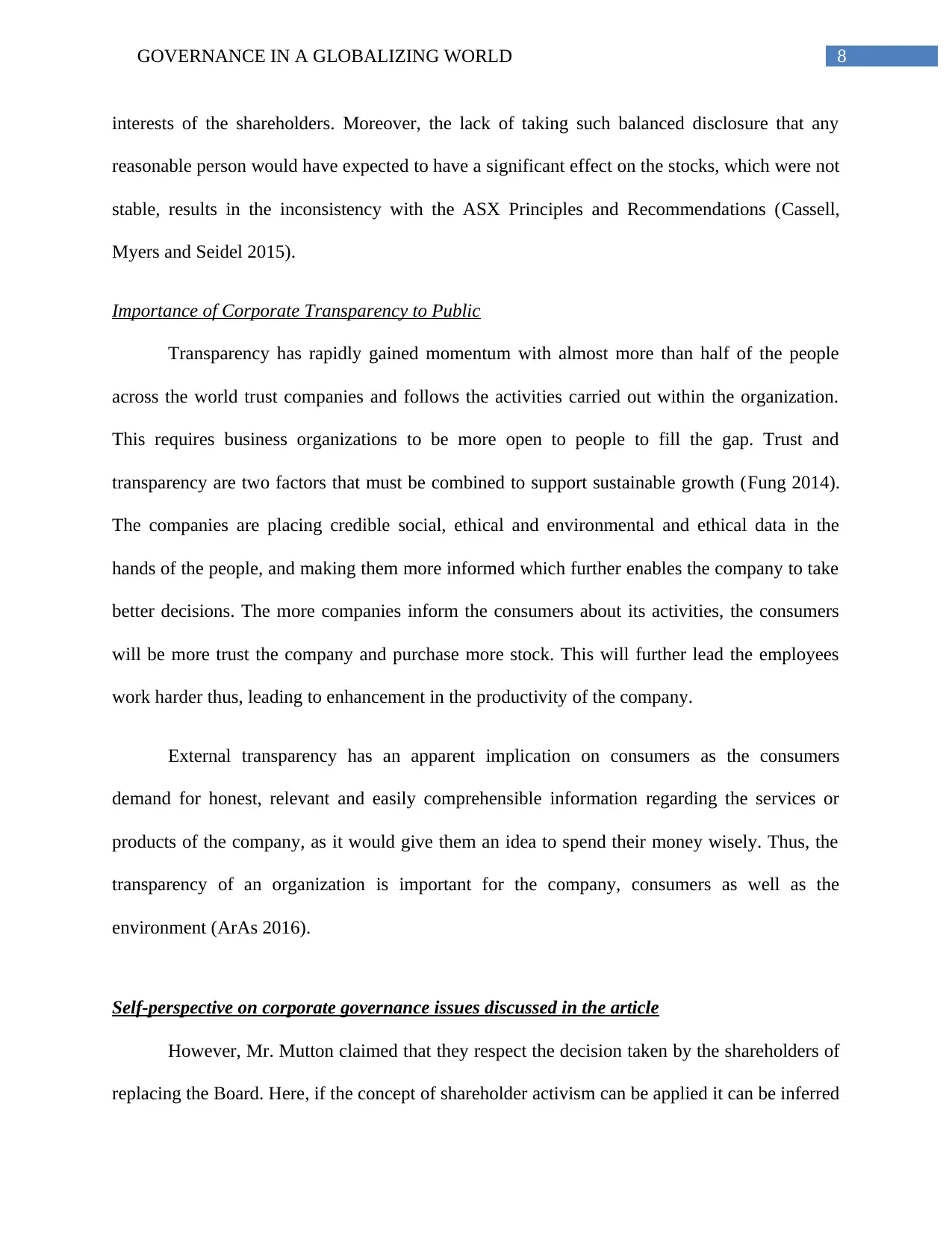
8GOVERNANCE IN A GLOBALIZING WORLD
interests of the shareholders. Moreover, the lack of taking such balanced disclosure that any
reasonable person would have expected to have a significant effect on the stocks, which were not
stable, results in the inconsistency with the ASX Principles and Recommendations (Cassell,
Myers and Seidel 2015).
Importance of Corporate Transparency to Public
Transparency has rapidly gained momentum with almost more than half of the people
across the world trust companies and follows the activities carried out within the organization.
This requires business organizations to be more open to people to fill the gap. Trust and
transparency are two factors that must be combined to support sustainable growth (Fung 2014).
The companies are placing credible social, ethical and environmental and ethical data in the
hands of the people, and making them more informed which further enables the company to take
better decisions. The more companies inform the consumers about its activities, the consumers
will be more trust the company and purchase more stock. This will further lead the employees
work harder thus, leading to enhancement in the productivity of the company.
External transparency has an apparent implication on consumers as the consumers
demand for honest, relevant and easily comprehensible information regarding the services or
products of the company, as it would give them an idea to spend their money wisely. Thus, the
transparency of an organization is important for the company, consumers as well as the
environment (ArAs 2016).
Self-perspective on corporate governance issues discussed in the article
However, Mr. Mutton claimed that they respect the decision taken by the shareholders of
replacing the Board. Here, if the concept of shareholder activism can be applied it can be inferred
interests of the shareholders. Moreover, the lack of taking such balanced disclosure that any
reasonable person would have expected to have a significant effect on the stocks, which were not
stable, results in the inconsistency with the ASX Principles and Recommendations (Cassell,
Myers and Seidel 2015).
Importance of Corporate Transparency to Public
Transparency has rapidly gained momentum with almost more than half of the people
across the world trust companies and follows the activities carried out within the organization.
This requires business organizations to be more open to people to fill the gap. Trust and
transparency are two factors that must be combined to support sustainable growth (Fung 2014).
The companies are placing credible social, ethical and environmental and ethical data in the
hands of the people, and making them more informed which further enables the company to take
better decisions. The more companies inform the consumers about its activities, the consumers
will be more trust the company and purchase more stock. This will further lead the employees
work harder thus, leading to enhancement in the productivity of the company.
External transparency has an apparent implication on consumers as the consumers
demand for honest, relevant and easily comprehensible information regarding the services or
products of the company, as it would give them an idea to spend their money wisely. Thus, the
transparency of an organization is important for the company, consumers as well as the
environment (ArAs 2016).
Self-perspective on corporate governance issues discussed in the article
However, Mr. Mutton claimed that they respect the decision taken by the shareholders of
replacing the Board. Here, if the concept of shareholder activism can be applied it can be inferred
⊘ This is a preview!⊘
Do you want full access?
Subscribe today to unlock all pages.

Trusted by 1+ million students worldwide
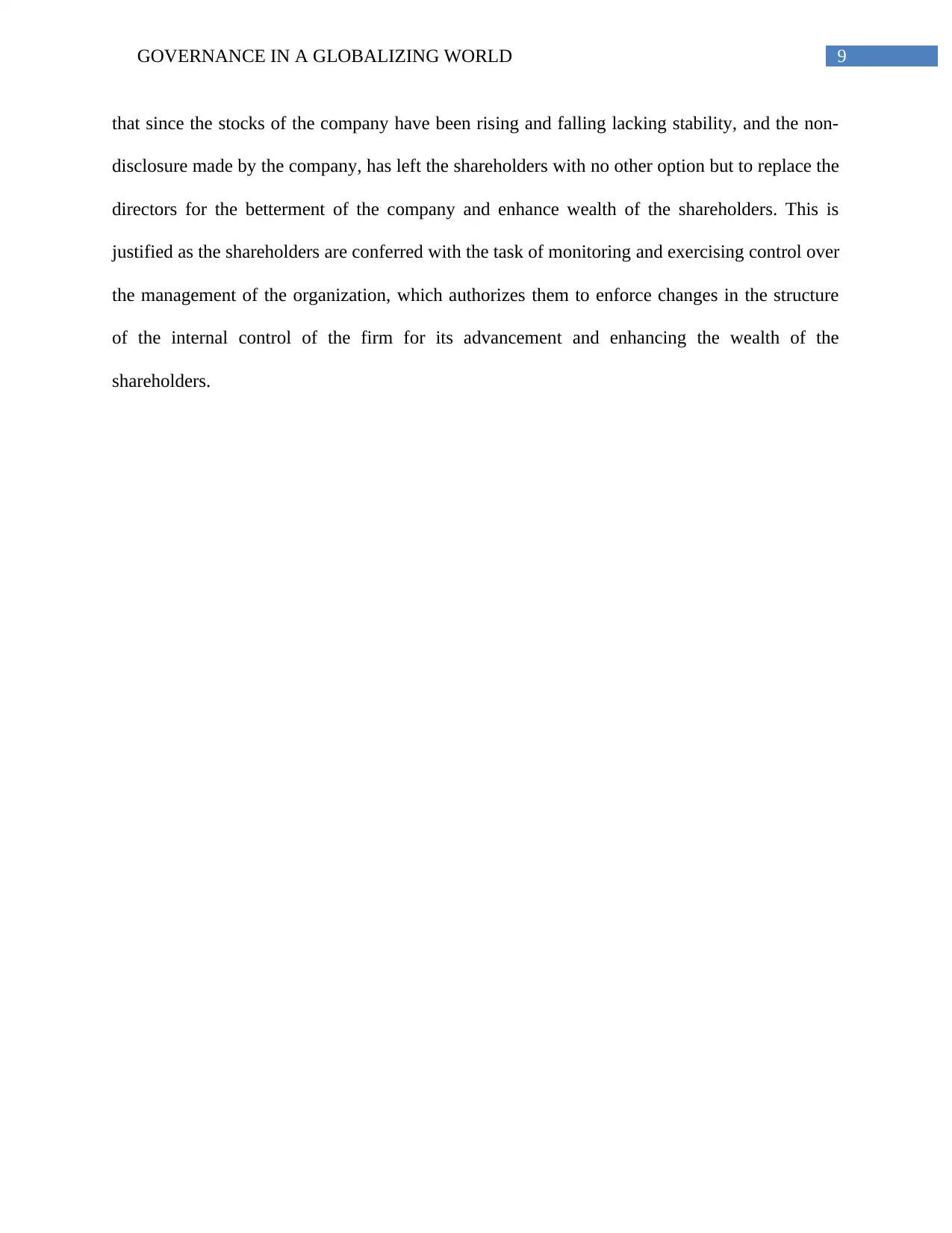
9GOVERNANCE IN A GLOBALIZING WORLD
that since the stocks of the company have been rising and falling lacking stability, and the non-
disclosure made by the company, has left the shareholders with no other option but to replace the
directors for the betterment of the company and enhance wealth of the shareholders. This is
justified as the shareholders are conferred with the task of monitoring and exercising control over
the management of the organization, which authorizes them to enforce changes in the structure
of the internal control of the firm for its advancement and enhancing the wealth of the
shareholders.
that since the stocks of the company have been rising and falling lacking stability, and the non-
disclosure made by the company, has left the shareholders with no other option but to replace the
directors for the betterment of the company and enhance wealth of the shareholders. This is
justified as the shareholders are conferred with the task of monitoring and exercising control over
the management of the organization, which authorizes them to enforce changes in the structure
of the internal control of the firm for its advancement and enhancing the wealth of the
shareholders.
Paraphrase This Document
Need a fresh take? Get an instant paraphrase of this document with our AI Paraphraser
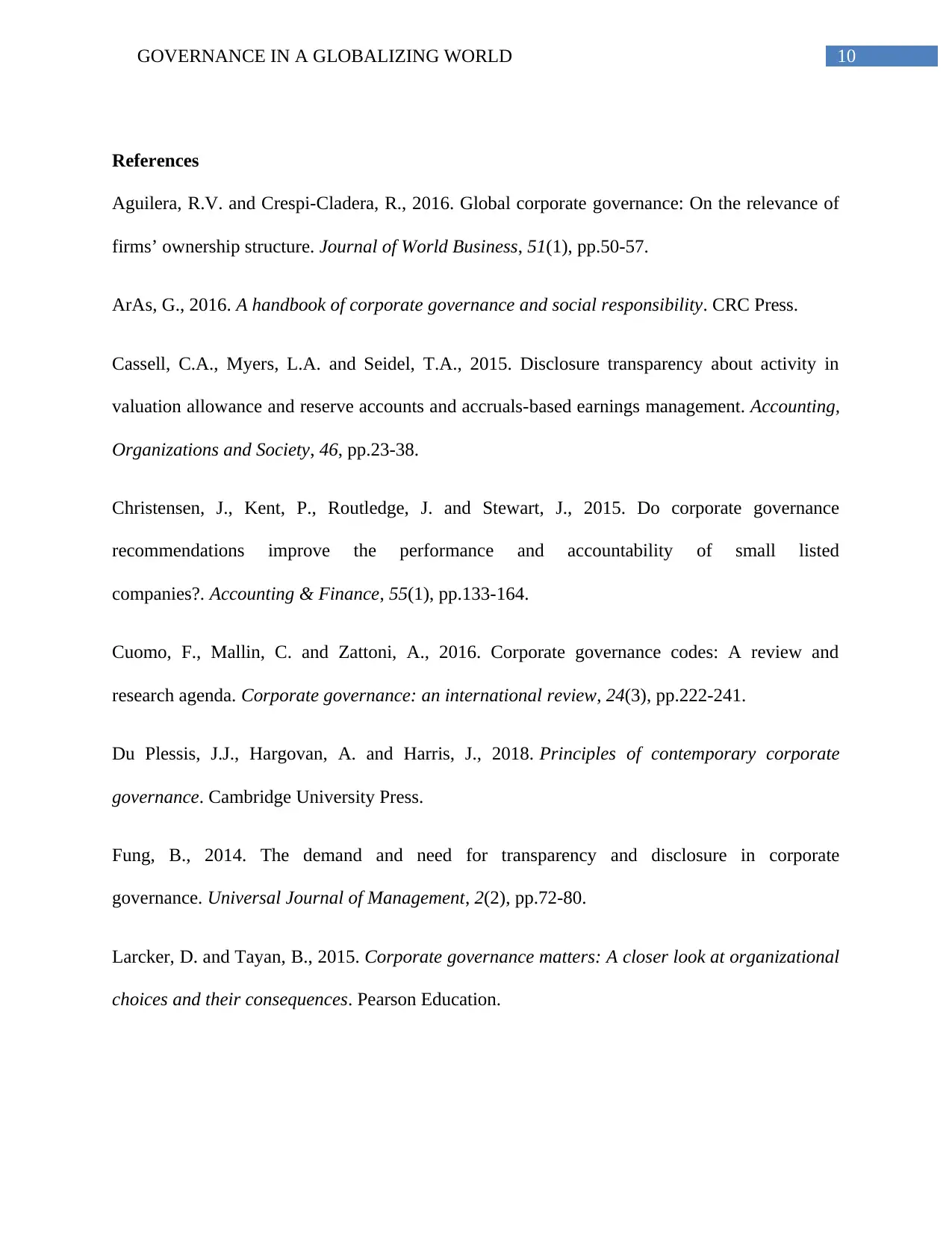
10GOVERNANCE IN A GLOBALIZING WORLD
References
Aguilera, R.V. and Crespi-Cladera, R., 2016. Global corporate governance: On the relevance of
firms’ ownership structure. Journal of World Business, 51(1), pp.50-57.
ArAs, G., 2016. A handbook of corporate governance and social responsibility. CRC Press.
Cassell, C.A., Myers, L.A. and Seidel, T.A., 2015. Disclosure transparency about activity in
valuation allowance and reserve accounts and accruals-based earnings management. Accounting,
Organizations and Society, 46, pp.23-38.
Christensen, J., Kent, P., Routledge, J. and Stewart, J., 2015. Do corporate governance
recommendations improve the performance and accountability of small listed
companies?. Accounting & Finance, 55(1), pp.133-164.
Cuomo, F., Mallin, C. and Zattoni, A., 2016. Corporate governance codes: A review and
research agenda. Corporate governance: an international review, 24(3), pp.222-241.
Du Plessis, J.J., Hargovan, A. and Harris, J., 2018. Principles of contemporary corporate
governance. Cambridge University Press.
Fung, B., 2014. The demand and need for transparency and disclosure in corporate
governance. Universal Journal of Management, 2(2), pp.72-80.
Larcker, D. and Tayan, B., 2015. Corporate governance matters: A closer look at organizational
choices and their consequences. Pearson Education.
References
Aguilera, R.V. and Crespi-Cladera, R., 2016. Global corporate governance: On the relevance of
firms’ ownership structure. Journal of World Business, 51(1), pp.50-57.
ArAs, G., 2016. A handbook of corporate governance and social responsibility. CRC Press.
Cassell, C.A., Myers, L.A. and Seidel, T.A., 2015. Disclosure transparency about activity in
valuation allowance and reserve accounts and accruals-based earnings management. Accounting,
Organizations and Society, 46, pp.23-38.
Christensen, J., Kent, P., Routledge, J. and Stewart, J., 2015. Do corporate governance
recommendations improve the performance and accountability of small listed
companies?. Accounting & Finance, 55(1), pp.133-164.
Cuomo, F., Mallin, C. and Zattoni, A., 2016. Corporate governance codes: A review and
research agenda. Corporate governance: an international review, 24(3), pp.222-241.
Du Plessis, J.J., Hargovan, A. and Harris, J., 2018. Principles of contemporary corporate
governance. Cambridge University Press.
Fung, B., 2014. The demand and need for transparency and disclosure in corporate
governance. Universal Journal of Management, 2(2), pp.72-80.
Larcker, D. and Tayan, B., 2015. Corporate governance matters: A closer look at organizational
choices and their consequences. Pearson Education.
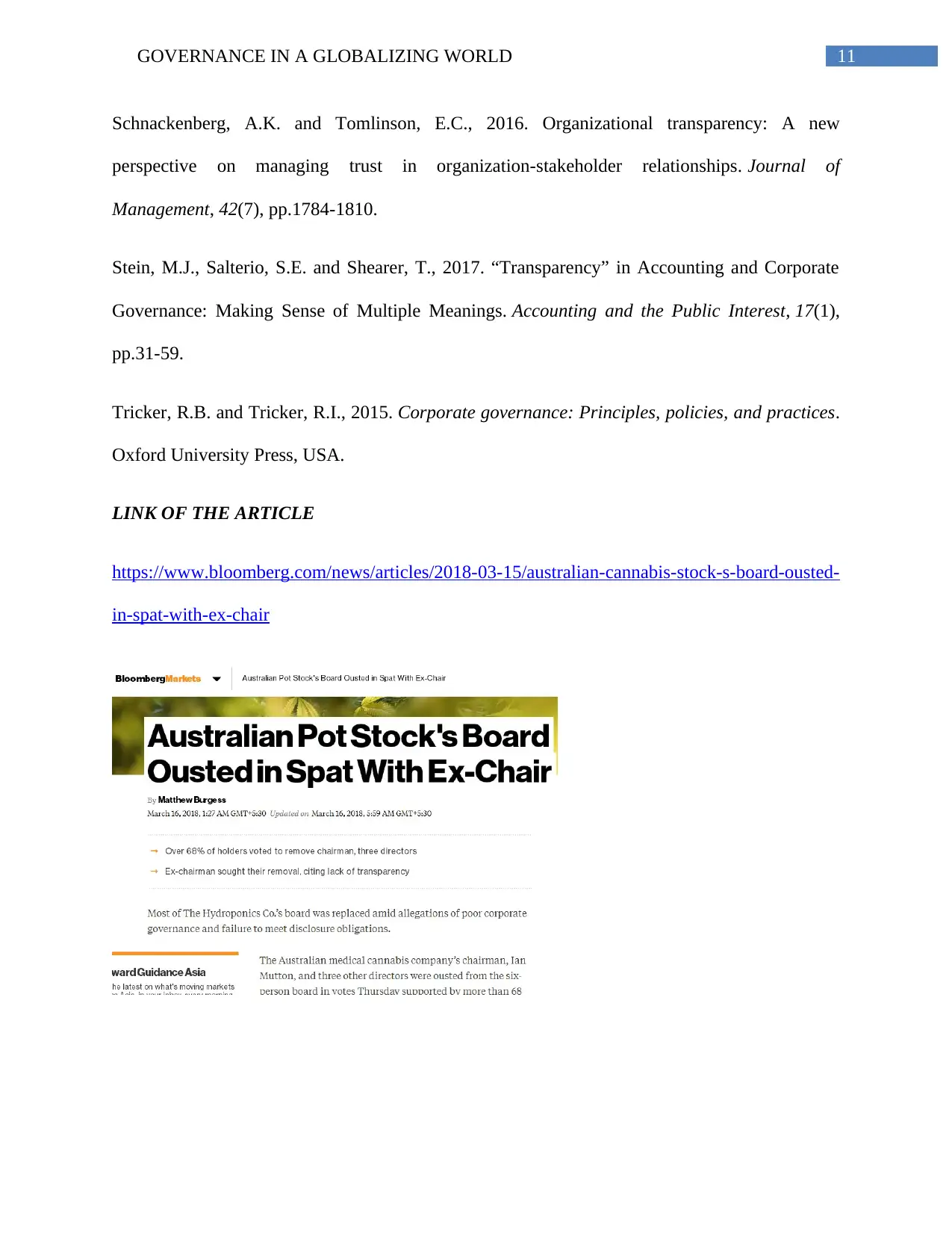
11GOVERNANCE IN A GLOBALIZING WORLD
Schnackenberg, A.K. and Tomlinson, E.C., 2016. Organizational transparency: A new
perspective on managing trust in organization-stakeholder relationships. Journal of
Management, 42(7), pp.1784-1810.
Stein, M.J., Salterio, S.E. and Shearer, T., 2017. “Transparency” in Accounting and Corporate
Governance: Making Sense of Multiple Meanings. Accounting and the Public Interest, 17(1),
pp.31-59.
Tricker, R.B. and Tricker, R.I., 2015. Corporate governance: Principles, policies, and practices.
Oxford University Press, USA.
LINK OF THE ARTICLE
https://www.bloomberg.com/news/articles/2018-03-15/australian-cannabis-stock-s-board-ousted-
in-spat-with-ex-chair
Schnackenberg, A.K. and Tomlinson, E.C., 2016. Organizational transparency: A new
perspective on managing trust in organization-stakeholder relationships. Journal of
Management, 42(7), pp.1784-1810.
Stein, M.J., Salterio, S.E. and Shearer, T., 2017. “Transparency” in Accounting and Corporate
Governance: Making Sense of Multiple Meanings. Accounting and the Public Interest, 17(1),
pp.31-59.
Tricker, R.B. and Tricker, R.I., 2015. Corporate governance: Principles, policies, and practices.
Oxford University Press, USA.
LINK OF THE ARTICLE
https://www.bloomberg.com/news/articles/2018-03-15/australian-cannabis-stock-s-board-ousted-
in-spat-with-ex-chair
⊘ This is a preview!⊘
Do you want full access?
Subscribe today to unlock all pages.

Trusted by 1+ million students worldwide
1 out of 13
Your All-in-One AI-Powered Toolkit for Academic Success.
+13062052269
info@desklib.com
Available 24*7 on WhatsApp / Email
![[object Object]](/_next/static/media/star-bottom.7253800d.svg)
Unlock your academic potential
Copyright © 2020–2025 A2Z Services. All Rights Reserved. Developed and managed by ZUCOL.